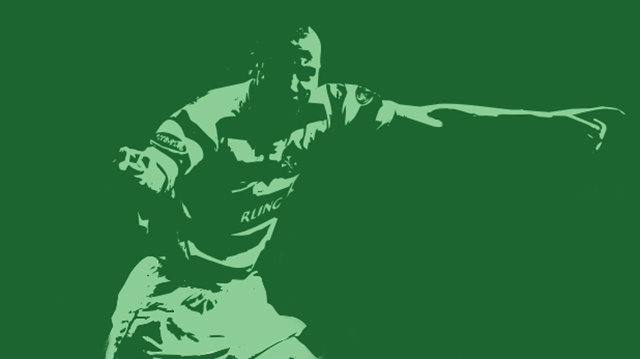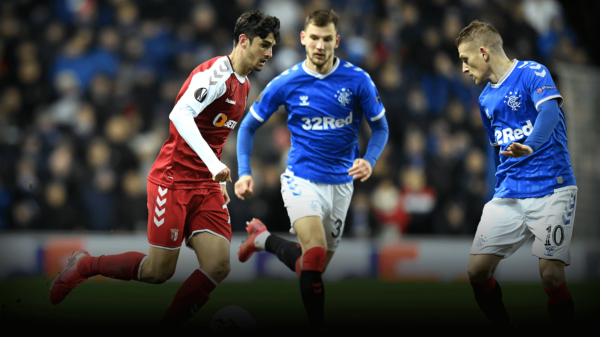Liam Bekker chronicles the career of one of the greatest pure goal-scorers to ever grace the beautiful game, the legendary, Henrik Larsson.

For fifteen years Swedish lower-league side Högaborgs was the home of one Henrik Larsson. The prolific striker joined the club when he was just six years old and worked his way up to the senior side where he made his debut at age 17. He scored 23 goals during his three years in the first team before a trial at Benfica (then coached by Swedish manager Sven-Göran Eriksson) led to his departure in 1992.
Initial rise and subsequent struggles
He did not leave to join Benfica, though, but rather signed for fellow Swedish club Helsingborg. The club had signed Larsson on the recommendation of striker Mats Magnusson who had been on the books of Benfica at the time of Larsson’s trial there. It was at Helsingborg where Larsson’s true goal scoring prowess would come to the fore for the first time as in his debut season he netted 34 goals and helped them secure promotion to the Allsvenskan – the Swedish top division. The jump from second division to top flight required little adjustment for Larsson who then proceeded to net an impressive 16 league goals the following season. His fine form in front of goal caught the attention of some of Sweden’s biggest clubs but it was Dutch giants Feyernood, led by Wim Jansen, who managed to secure his signature in November 1993.
Larsson struggled to adjust in Holland, though, and managed a return of just 6 goals in his first season. Media criticism, managerial instability and constant positional rotations compounded Larsson’s goal scoring inconsistencies to such an extent that in 1997 he felt no other option than to try and force a move away from De Kuip. An ugly court battle ensued regarding Larsson’s release clause (which he won) before Celtic’s newly appointed manager – Wim Jansen – rescued the Swede once more and signed him for the Scottish club. All-in-all Larsson represented Feyernood 149 times, scored 42 goals and departed Holland with two KNVB Cup winners’ medals to his name.
Celtic’s cult-hero
The move to Celtic proved to be the defining moment in Larsson’s career. Despite starting off poorly by inadvertently setting up Hibernian’s Chris Charnley (which subsequently cost Celtic the match) on debut, the dreadlocked Swede ended his first season as Celtic’s top goal scorer with 19 goals and played an instrumental role in the clubs double winning season. Larsson netted the second goal in Celtic’s 3-0 win over Dundee United in the Scottish League Cup final and his 16 league goals helped The Hoops on their way to a first League title in 10 years, making him an instant favourite amongst the clubs fans.
Larsson’s impressive debut season set the backdrop for what would become one of the most phenomenal goal scoring careers of any player to have worn Celtic’s famous green and white kit. The prolific Swede scored an incredible 38 goals the following season, earning him a treble of individual accolades in the form of the SPFA Players’ Player of the Year, SFWA Footballer of the Year and Swedish Footballer of the Year awards. It was a case of more of the same the following season as Larsson netted an impressive 12 goals in just 13 matches before a double-break in his leg ended his season prematurely and threatened to bring an end to his career as a whole.
But Henrik Larsson had overcome adversity his whole life. As a youngster he was subjected to racial abuse as a result of his Cape Verdean roots, in his latter teen years he toiled as a fruit-picker while trying to make something of a fleeting dream of playing football, and then, at Feyernood, he faced the public wrath of the board, media and fans alike. Each time he had walked away a stronger person and a better player and things would be no different this time.
The Swedish international missed 8 months of football as a result of the injury but returned better than ever, forming a brilliant strike-partnership with Chris Sutton to lead Celtic to a domestic treble. Larsson netted a hat-trick in the Scottish League Cup final and a brace in the Scottish Cup but topped it all off with an incredible tally of 35 league goals – a haul that saw him win the SPFA Players’ Player of the Year and SFWA Footballer of the Year awards again as well as the prize for the league’s top goal scorer. His remarkable goal scoring exploits also earned him the much coveted European Golden Shoe award, making him the first, and to this date only Celtic player to have won the award. (He scored 53 goals in just 50 appearances in all competitions that season.)
Larsson gliding away in his trademark tongue-out celebration was an all too common site at Celtic Park over the next three seasons, with the Swede netting a further 119 goals during that time. Indeed, even his final competitive game for the club ended in typical fashion with the Hoops’ legend netting a brace to guide Celtic to victory in the 2004 Scottish Cup final. A fairy-tale ending if ever there was one.
Larsson’s departure was an emotional affair, not only for himself but for the thousands upon thousands of Celtic fans whose hearts he had won over. During his time at Celtic he had no equal. His off-the-ball intelligence, movement and clinical finishing had made him a legend at the club. He was a unique talent and the club was truly blessed to have called him their own and though not a single person wanted him to leave, no one begrudged him his move to Barcelona. Larsson had loyally fought for Celtic throughout the years of his prime, rejecting the overtures of many of Europe’s elite clubs, but found that the time had finally come to test his ability at the highest level.
All in all Larsson won four SPL titles, two Scottish League Cups and two Scottish Cups; was the Scottish Premier League’s top goal scorer in five of the six seasons he played in Scotland (missing out through injury in 99/00), scored 241 goals and left the country as Celtic’s third top scorer of all-time and the SPL’s all-time greatest goal getter with 158 goals (a record which was broken in 2009 by Kris Boyd).
The Spanish adventure & the Manchester stint
Larsson spent two seasons at Barcelona and though he was no longer the goal scoring machine of years gone by, he still proved to be an efficient weapon for the Catalan club in the super-sub role. This was never more evident than in the 2006 Champions League final against Arsenal where, with the team trailing 1-0, Larsson came off the bench and set up both goals as Barca came from behind to win 2-1. His decision to leave Celtic had been justified by his lifting of the famous trophy and served as the crowning jewel atop the two La Liga titles he had already won with the team. By the end of his stay in Catalonia, Larsson had played 58 games for Barcelona, scoring a handy 18 goals.
With his contract at Barcelona ending Larsson took the opportunity to return to Sweden and reunite with former club Helsingborg. His homecoming was sweet with the 35-year old ending the season with a Swedish Cup title to his name. Testament to his quality, Man United overlooked his age and signed him on loan during the Allsvenskan off-season. He only spent three months with the Red Devils but such was his class that he left with the adulation of the fans and players alike. Sir Alex Ferguson could not praise the veteran Swede enough and even tried to convince him to stay at Old Trafford but Larsson kept true to his promise to Helsingborg and returned to Sweden for the start of the new season – He later received special dispensation to receive a winners medal as Man United went on to win the Premier League.
Larsson returned to spend three more seasons at Helsingborg, scoring another 42 goals before finally calling it quits on his illustrious career.
Sweden’s Golden Boy
Throughout his footballing journey, Larsson’s heroic exploits at club level were well supplemented with his performances with the Swedish national team. He made his debut for Sweden in 1993 in what was the beginning of a 16-year career with the national team and went on to lead the line for Blågult at three World Cups and three European Championships. Though Sweden never really challenged at the major competitions Larsson was at his individual best throughout and managed to win the Goal of the Tournament award for his goal against Bulgaria at Euro 2004. He had three spells with the national team (having retired in 2002 and 2004), amassing an incredible 106 caps and scoring 37 goals before hanging up his international boots once and for all on the 11th of October 2009, just 9 days before announcing his retirement from all football.
Though a late bloomer when compared to some of football’s other legends, Larsson ultimately developed into one of the world’s best players. His brilliant movement and ruthless instinct in front of goal made him one of the most feared and prolific strikers around. Larsson was revered at Helsingborg and adored in Manchester but none loved him more than the Celtic faithful. He was their four-leaf clover that led them to title after title (after title) and remains firmly in their hearts as one of the clubs greatest ever players.
Written by Liam Bekker
- 2016-17 Rule Changes: An interview with Dr. Errol Sweeney - July 6, 2016
- Scout Report | Stephane Sparagna: Marseille’s combative young centre-back - December 22, 2015
- Remember the name: Goal scoring machine, Ruud van Nistelrooy - July 6, 2015




























































